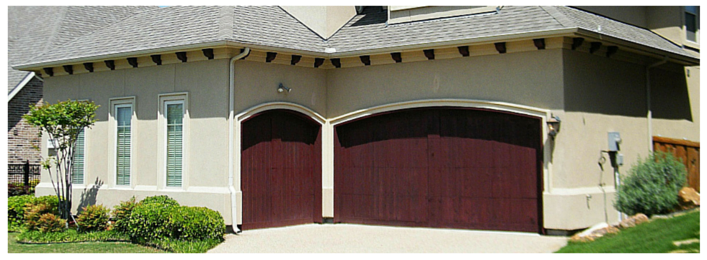Designing a Custom Garage Door
- 1. Architecture
- 2. Styles
- 3. Type
- 4. Panels
- 5. Material
- 6. Options
- 7. Estimate
Step 6. Choose Options

Insulated vs. Non-Insulated?
- If you use your garage for storage, thermal insulation is an important factor to consider in your garage door search.
- Insulating a garage door can make the garage quieter.
- If you have a garage workshop or tend to do projects in that space, you will want to consider insulating your garage door to make it more comfortable in warmer and colder months.
- Insulated doors tend to be thicker and resist dents
- Choose R-value between 4-17. The higher the R-value, the greater the insulating properties.
- Styrene foam insulation and rigid polyurethane foam is available in lightweight panels that are easily cut to fit in the framework of sectional doors. Larger panels and spray adhesive also used for one-piece metal and wood garage doors.
- More on Insulated Garage Doors
Choose Color
The details make a home, which is why the garage door color is so important! If you plan on painting your garage door, consider a few tips:
- If your home is a neutral color, like beige or gray, a white door will give it a cleaner, brighter appearance.
- If your home is white, adding a bit of color is a great way to brighten up the home while still keeping it simple.
- The key is to create contrast.
- If you do not want to draw attention to your garage door, match it to the color of your house.
- Most manufacturers offer a choice of colors but you can paint your garage door the color of your choice with latex paint.
Choose Window-Type
If adding windows, choose the location of the windows and the design bevelite, etched or decorative trim
Add Decorative Hardware
- Pulls
- Latches
- Hinges
Garage Door Opener
- Ceiling Mount
- Wall Mount
- More on Garage Door Openers
Features
Safety Features
- Pinch-resistant panels
- Temper-resistant bottom fixtures prevent the accidental release of the powerful spring load
- More on Safety
Other Features:
- Polymer hinges with no metal-on-metal moving parts
- Between section seals to reduce air infiltration
- Spring-tensioned polymer or nylon rollers for smooth, quiet performance
- High tensile strength steel for dent resistance
- Bulb-type bottom seal for an added barrier against wind and rain
- A full-length bottom weather seal to ensure protection against wind, rain and dust.
- Rigid galvanized steel center stiles for strength
- Sturdy rail and stile construction and rabbeted section joint for added durability.
- Extension springs
- On either side of the track, often used on lighter doors and single car garages
- Torsion springs
- Typically one or two along the wall above the door opening for heavier doors and 2 or 3-car garages.
- The torsion spring distributes the weight of the door more evenly, particularly with a very wide extremely heavy door. Torsion Spring Cycles are 25,000, 50,000, 75,000 or 100,000. To determine what cycle you need, take the average # of times the garage goes up and down each day and multiply it by 250 days and then multiply it by 10 years. Average life of garage door is 10 years.
- Galvanized torsion springs – Resist corrosion. Last 50% longer than other types of springs.
Designing your Garage Door
